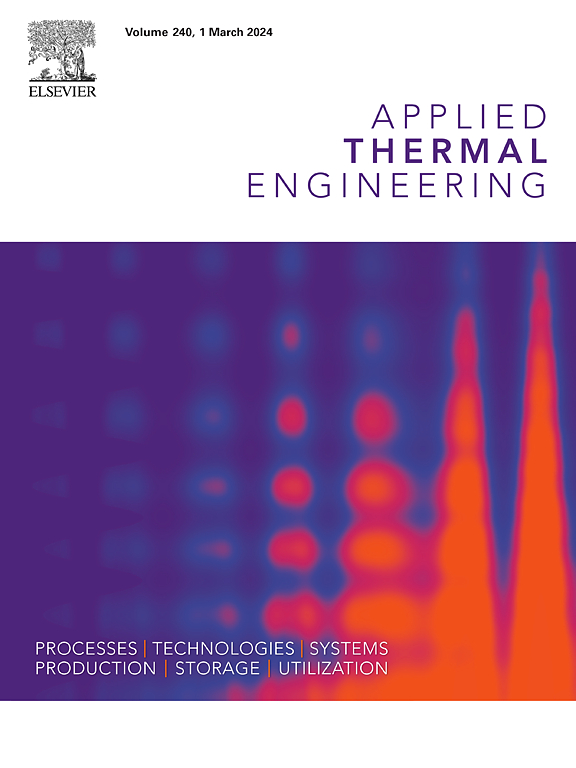Optimisation of PCM passive cooling efficiency on lithium-ion batteries based on coupled CFD and ANN techniques
IF 6.1
2区 工程技术
Q2 ENERGY & FUELS
引用次数: 0
Abstract
Ever since the lithium-ion batteries (LIBs) outbreak, there has been an exponential bloom of application over the last decade, especially for electric vehicles, automobiles and other transportation systems. Nonetheless, as the first-generation LIBs eventually aged and became increasingly thermally unstable, the utilisation of thermal management cooling systems is essential to maintain the safe operation of LIB packs in the long term. Compared to active cooling methods, passive cooling often offers a cost-effective, easy-to-install and energy-saving solution without significant changes to the design complexity. This article focuses on the thermal management of prismatic battery packs and proposes a coupling passive cooling method that combines phase change material (PCM) cooling and immersion cooling, which proves to be cost-effective and efficient. Furthermore, the study incorporates an artificial neural network (ANN) model into computational fluid dynamics (CFD) simulations to optimize a specific battery cooling system. This optimization takes into account the PCM package method and the properties of PCM and immersion liquid. The results demonstrate that the immersion liquid exhibits different behaviours under various PCM conditions than natural convection. Overall, this modelling framework presents an innovative approach by utilizing high-fidelity CFD numerical results as inputs for establishing a numerical dataset. Through ANN optimisation, eleven input parameters are considered, and the optimised scenario confirmed that PCM material with a density of 760 kg/m3, thermal conductivity 32 W/(m K), specific heat 1691 (J/kg K), latent heat 80,160 (J/kg), liquidus temperature 302.93 K, solidus temperature 315.15 K and direct liquid density 1.4 (g/ml), thermal conductivity 0.4 (W/m K), specific heat 1220 (J/kg K) with side thickness 5 (mm) and mid thickness 2.5 (mm). With this combination, the optimised performance demonstrated considerable decreases in the maximum temperature and the temperature difference by 4.26 % and 10.8 %, respectively. This approach has the potential to enhance the state-of-the-art thermal management of LIB systems, reducing the risks of thermal runaway and fire outbreaks.
基于 CFD 和 ANN 耦合技术优化锂离子电池的 PCM 被动冷却效率
自从锂离子电池(LIB)问世以来,其应用在过去十年中呈指数级增长,尤其是在电动汽车、汽车和其他运输系统中。然而,随着第一代锂离子电池的老化和热不稳定性的增加,热管理冷却系统的使用对于维持锂离子电池组的长期安全运行至关重要。与主动冷却方法相比,被动冷却通常能提供一种成本效益高、易于安装且节能的解决方案,而不会对设计的复杂性造成重大改变。本文重点关注棱柱电池组的热管理,并提出了一种结合相变材料(PCM)冷却和浸入式冷却的耦合被动冷却方法,事实证明这种方法既经济又高效。此外,该研究还在计算流体动力学(CFD)模拟中加入了人工神经网络(ANN)模型,以优化特定的电池冷却系统。这种优化考虑到了 PCM 封装方法以及 PCM 和浸入液体的特性。结果表明,在各种 PCM 条件下,浸入液体表现出与自然对流不同的行为。总之,该建模框架提出了一种创新方法,即利用高保真 CFD 数值结果作为建立数值数据集的输入。通过 ANN 优化,考虑了 11 个输入参数,优化方案确认 PCM 材料的密度为 760 kg/m3,导热系数为 32 W/(m K),比热为 1691(J/kg K),潜热为 80160(J/kg),液相温度为 302.93 K,固相温度为 315.15 K,直接液体密度为 1.4(g/ml),导热系数为 0.4(W/m K),比热为 1220(J/kg K),侧厚为 5(mm),中厚为 2.5(mm)。通过这种组合,优化后的性能表现为最高温度和温差大幅降低,分别降低了 4.26 % 和 10.8 %。这种方法有望提高 LIB 系统的先进热管理水平,降低热失控和火灾爆发的风险。
本文章由计算机程序翻译,如有差异,请以英文原文为准。
求助全文
约1分钟内获得全文
求助全文
来源期刊

Applied Thermal Engineering
工程技术-工程:机械
CiteScore
11.30
自引率
15.60%
发文量
1474
审稿时长
57 days
期刊介绍:
Applied Thermal Engineering disseminates novel research related to the design, development and demonstration of components, devices, equipment, technologies and systems involving thermal processes for the production, storage, utilization and conservation of energy, with a focus on engineering application.
The journal publishes high-quality and high-impact Original Research Articles, Review Articles, Short Communications and Letters to the Editor on cutting-edge innovations in research, and recent advances or issues of interest to the thermal engineering community.
 求助内容:
求助内容: 应助结果提醒方式:
应助结果提醒方式:


